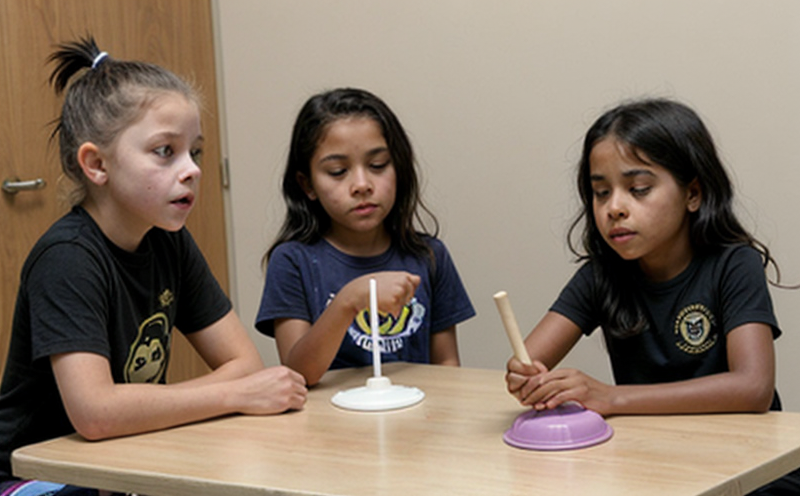ASTM D3475-22 Random Child Accessibility Test
The ASTM D3475-22 Random Child Accessibility Test is a critical procedure designed to evaluate the effectiveness of child-resistant packaging. This test ensures that children under five years old cannot access the contents of the package without significant difficulty, while still allowing adults and older children easy access. The test involves simulating various scenarios in which the package might be handled by a small child, including grasping, shaking, and opening attempts.
The ASTM D3475 standard outlines specific criteria for determining whether packaging meets the requirements for child resistance. These tests are essential for ensuring compliance with regulatory standards set by agencies such as the U.S. Consumer Product Safety Commission (CPSC) and similar bodies in other countries. Failure to meet these standards can result in product recalls, legal action, and damage to brand reputation.
The test procedure typically involves placing a standard size package containing a model child-sized hand or an actual small child's hand inside the packaging. The package is then subjected to various manipulations that simulate real-world scenarios where children might interact with it. The goal is to determine if the package remains closed and secure under these conditions.
For instance, the test may involve shaking the package vigorously or attempting to open it using a child-sized hand. If the package opens easily under such conditions, it fails the test and does not meet the required standards for child resistance. The test is designed to be rigorous enough to catch potential design flaws that could lead to accidental access by children.
The ASTM D3475-22 standard also includes provisions for conducting a "random child accessibility" test, which involves exposing the package to multiple handling attempts by different individuals under various conditions. This ensures that even if one person can easily open the package, others cannot. The test is conducted in such a way as to simulate real-world scenarios where children might interact with the packaging.
The results of this testing are crucial for ensuring product safety and compliance with regulatory requirements. By conducting these tests, manufacturers can verify that their packaging meets the necessary standards for child resistance. This not only protects children from potential harm but also ensures that adults have easy access to the contents when needed. The test is particularly important for products such as medications, cosmetics, and other potentially harmful substances.
Understanding the ASTM D3475-22 Random Child Accessibility Test involves recognizing its importance in ensuring product safety and compliance with regulatory standards. This test is a key component of quality assurance processes in various industries, including pharmaceuticals, personal care products, and household chemicals.
Why It Matters
The ASTM D3475-22 Random Child Accessibility Test is crucial for ensuring the safety of children who might come into contact with potentially harmful substances. This test helps manufacturers and regulators verify that packaging meets the necessary standards for child resistance, thereby reducing the risk of accidental ingestion or exposure.
By conducting this test, companies can demonstrate their commitment to product safety and regulatory compliance. Failure to meet these standards could result in legal action, product recalls, and damage to brand reputation. The test is particularly important for products such as medications, cosmetics, and household chemicals that might be harmful if accessed by children.
The ASTM D3475-22 Random Child Accessibility Test also plays a vital role in protecting the health of consumers. By ensuring that packaging meets the necessary standards for child resistance, companies can help prevent accidents and injuries caused by accidental access to potentially dangerous substances.
Moreover, this test is essential for maintaining consumer trust and confidence in products. When consumers know that packaging has been tested and certified as child-resistant, they are more likely to feel safe using the product. This can lead to increased sales and customer satisfaction.
Applied Standards
| Standard | Description |
|---|---|
| ASTM D3475-22 | This standard provides detailed procedures for conducting the Random Child Accessibility Test. It outlines specific criteria for determining whether packaging meets the requirements for child resistance. |
| ISO 8124-6:2014 | This international standard specifies the test methods for evaluating the resistance of toys and similar articles to being opened by children under five years old. While not specific to packaging, it provides valuable insights into the principles behind child-resistant design. |
| EN 17524:2018 | This European standard sets out requirements for child-resistant closures on containers of oral medicinal products. It is particularly relevant for pharmaceutical packaging. |
The ASTM D3475-22 Random Child Accessibility Test is based on these standards, ensuring that the test procedures are rigorous and consistent with international best practices. By adhering to these standards, companies can ensure that their packaging meets the necessary requirements for child resistance.
Eurolab Advantages
At Eurolab, we pride ourselves on offering comprehensive testing services that meet the highest standards of accuracy and reliability. Our experienced team of professionals is dedicated to ensuring that your packaging meets all necessary requirements for child resistance.
We have state-of-the-art facilities and equipment designed specifically for conducting ASTM D3475-22 tests. Our laboratories are equipped with the latest technology, allowing us to provide precise and consistent test results. This ensures that you can trust our services to meet your testing needs.
Our team of experts is well-versed in all aspects of child-resistant packaging design and testing. We work closely with clients to understand their specific requirements and develop tailored testing programs that meet those needs. Our goal is to provide you with the most accurate and reliable test results possible, ensuring that your product meets all necessary standards for child resistance.
We also offer a range of additional services to support our testing capabilities. This includes providing expert advice on packaging design, helping clients understand the latest regulatory requirements, and offering training sessions to ensure that staff are up-to-date with the latest best practices in child-resistant packaging design.





